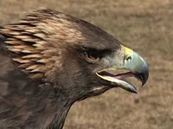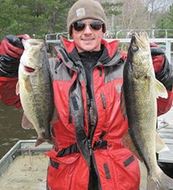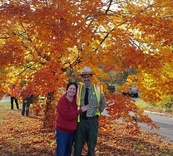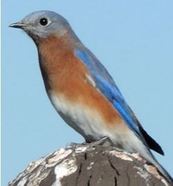Park Highlight: Cascade River State Park
In search of its shadow, the groundhog (or woodchuck) steals the spotlight in February while a plethora of other animals also move across the landscape this time of year. If you visit Cascade River State Park near Lutsen, you might spot a moose, gray wolf, pine marten or even the elusive great gray or boreal owls.
Visitors come to this state park for the rushing river and grand waterfalls that lay within a gorge, lush with moss and ferns that grow on black volcanic rocks. In winter, some of the falls freeze and create beautiful icy sculptures. Trails connect with the Superior Hiking Trail and the North Shore State Trail and offer great recreational opportunities to hikers and cross-country skiers. Drive-in and backpack campsites are available.

The List: Wildlife in Parks
Minnesota winters provide a stunning backdrop to any wildlife viewing. You can observe wildlife at every state park but some locations provide better opportunities to spy unique critters.
For example:
- In southeast Minnesota, Frontenac State Park is a hotspot for viewing bald eagles along the Mississippi River while the Whitewater Valley near Whitewater State Park attracts birdwatchers and photographers hoping to catch a glimpse of one of several pairs of wintering golden eagles.
- Near the Twin Cities, you may find a drowsy woodchuck waking from its winter slumber at Fort Snelling State Park where white-tailed deer, wild turkeys, fox and coyotes are also common.
- If you venture north this month, check out Jay Cooke State Park where pileated woodpeckers abound or visit the Mississippi River headwaters at Itasca State Park to search for signs of beavers and porcupines.
- Visit the prairie landscapes of southwest Minnesota to see bison year-round at both Minneopa and Blue Mounds State Parks, or look for muskrat along the Des Moines River at Kilen Woods State Park.
|
 Learn more about Minnesota wildlife.
Game Time: Outdoors in Every Language
Encourage your family to love the outdoors by exploring a variety of activities and finding ones that you enjoy together!
Below is an outdoor action word to share with young children to build literacy skills and to experience the joy of connecting with nature.
This month's outdoor action word is show! Explore your yard, neighborhood or nearby park to look for wildlife signs and tracks. Have each person in your family find something different. Take turns and show each other what you found. Take photos of signs or tracks you cannot identify so you can investigate with a field guide or on the Internet later.
An excerpt from “Let’s Play Outside! 50 Ways to Connect Kids with Nature,” a project of the 2014 Collaborative Leadership Fellows Program, Rochester, MN.

Traveler Tip: Wildlife Watching 101
Fight the winter blues by taking your family on a wildlife safari at your favorite Minnesota state park. Below are some simple tips for watching wildlife.
- Bring binoculars.
- Go out at dawn and dusk for the best viewing.
- Be alert and move slowly and quietly.
- Search for tracks in the mud or snow.
- Look near the edges of forests and fields, pond margins and treetops.
|
 Get more tips for finding and watching wildlife.

Discover: Wildlife Adapt to a Changing Climate
Have you noticed that temperatures are increasing and larger, more frequent extreme precipitation events are occurring in Minnesota? Climate change is impacting Minnesota's wildlife, plants, waters, historic resources, infrastructure, and outdoor recreation areas.
Some of the impacts of climate change on Minnesota wildlife that have been documented by researchers include:
- Warmer weather has made northern Minnesota more hospitable to deer, to the detriment of moose. Additionally, warmer winters allow winter ticks to flourish. At high enough levels, the ticks can kill moose.
- Many shallow duck ponds in southwest Minnesota have transitioned to fish lakes with increased water depths combined with milder winters reducing fish kills. The fish now compete directly with ducks for food sources like freshwater shrimp.
- Warmer winter temperatures mean rain events during the winter months. At this time of year, rain can't penetrate the frozen ground and instead runs into creeks, muddying the water and killing all sorts of young-of-the-year trout.
- Research from Wisconsin suggests higher temperatures lead to a loss of natural walleye reproduction and increased largemouth bass abundance. As the climate continues to warm in Minnesota, walleyes are expected to persist in larger lakes and fade from smaller, warmer lakes where largemouth bass will continue to thrive.
|
 Learn more about the impacts of climate change on our natural resources.

Meet the Field Staff
Get to know some of the field staff who take care of your Minnesota State Parks and Trails!
For the past 8 years, Don DelGreco has been a Park Manager at Maplewood State Park. He enjoys seeing people experience revelations of wonder in the beauty of nature. Don doesn't have one favorite spot at Maplewood State Park; he enjoys seeking and discovering new vantage points from which to perch and witness sunrises and sunsets.
One of Don's favorite outdoor activities is to capture images of butterflies and wildflowers with paintbrush (watercolors) and camera. His earliest memories as a child include being captivated by butterflies. The diminutive azure blue butterfly is his favorite because it carries a “touch of sky” on its wings and seems a perfect symbol of renewal and resurrection.
Don is grateful and humbled for the privilege and blessing to serve others in these beautiful landscapes and he considers it a joy and a gift to live, work and play in these special places.
|
 Interested in working for DNR? Check out DNR internship postings!

February Wildlife Programs
Stop by a Minnesota state park for wildlife programs including winter birding and how to identify animal tracks in the snow.
Upcoming programs include:
|
 Find more activities at Minnesota state parks and trails.
Discover more winter activity ideas at Explore Minnesota!
|